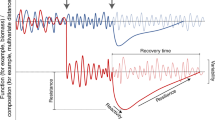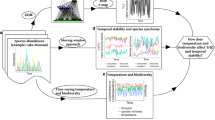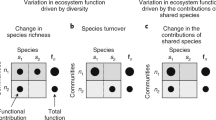Abstract
Losses and gains in species diversity affect ecological stability1,2,3,4,5,6,7 and the sustainability of ecosystem functions and services8,9,10,11,12,13. Experiments and models have revealed positive, negative and no effects of diversity on individual components of stability, such as temporal variability, resistance and resilience2,3,6,11,12,14. How these stability components covary remains poorly understood15. Similarly, the effects of diversity on overall ecosystem stability16, which is conceptually akin to ecosystem multifunctionality17,18, remain unknown. Here we studied communities of aquatic ciliates to understand how temporal variability, resistance and overall ecosystem stability responded to diversity (that is, species richness) in a large experiment involving 690 micro-ecosystems sampled 19 times over 40 days, resulting in 12,939 samplings. Species richness increased temporal stability but decreased resistance to warming. Thus, two stability components covaried negatively along the diversity gradient. Previous biodiversity manipulation studies rarely reported such negative covariation despite general predictions of the negative effects of diversity on individual stability components3. Integrating our findings with the ecosystem multifunctionality concept revealed hump- and U-shaped effects of diversity on overall ecosystem stability. That is, biodiversity can increase overall ecosystem stability when biodiversity is low, and decrease it when biodiversity is high, or the opposite with a U-shaped relationship. The effects of diversity on ecosystem multifunctionality would also be hump- or U-shaped if diversity had positive effects on some functions and negative effects on others. Linking the ecosystem multifunctionality concept and ecosystem stability can transform the perceived effects of diversity on ecological stability and may help to translate this science into policy-relevant information.
This is a preview of subscription content, access via your institution
Access options
Access Nature and 54 other Nature Portfolio journals
Get Nature+, our best-value online-access subscription
$29.99 / 30 days
cancel any time
Subscribe to this journal
Receive 51 print issues and online access
$199.00 per year
only $3.90 per issue
Buy this article
- Purchase on Springer Link
- Instant access to full article PDF
Prices may be subject to local taxes which are calculated during checkout



Similar content being viewed by others
Data availability
The experimental data that support the findings of this study are available at Github (https://github.com/pennekampster/Code_and_data_OverallEcosystemStability) with the identifier (https://doi.org/10.5281/zenodo.1345557). Source Data for Figs. 1–3 are provided in the online version of the paper.
References
Pimm, S. L. The complexity and stability of ecosystems. Nature 307, 321–326 (1984).
McCann, K. S. The diversity–stability debate. Nature 405, 228–233 (2000).
Ives, A. R. & Carpenter, S. R. Stability and diversity of ecosystems. Science 317, 58–62 (2007).
Allesina, S. & Tang, S. Stability criteria for complex ecosystems. Nature 483, 205–208 (2012).
Mougi, A. & Kondoh, M. Diversity of interaction types and ecological community stability. Science 337, 349–351 (2012).
Loreau, M. & de Mazancourt, C. Biodiversity and ecosystem stability: a synthesis of underlying mechanisms. Ecol. Lett. 16, 106–115 (2013).
Grilli, J., Barabás, G., Michalska-Smith, M. J. & Allesina, S. Higher-order interactions stabilize dynamics in competitive network models. Nature 548, 210–213 (2017).
Tilman, D. & Downing, J. A. Biodiversity and stability in grasslands. Nature 367, 363–365 (1994).
Pfisterer, A. B. & Schmid, B. Diversity-dependent production can decrease the stability of ecosystem functioning. Nature 416, 84–86 (2002).
Worm, B. et al. Impacts of biodiversity loss on ocean ecosystem services. Science 314, 787–790 (2006).
Cardinale, B. J. et al. Biodiversity loss and its impact on humanity. Nature 486, 59–67 (2012).
Wright, A. J. et al. Flooding disturbances increase resource availability and productivity but reduce stability in diverse plant communities. Nat. Commun. 6, 6092 (2015).
Isbell, F. et al. Biodiversity increases the resistance of ecosystem productivity to climate extremes. Nature 526, 574–577 (2015).
Isbell, F. I., Polley, H. W. & Wilsey, B. J. Biodiversity, productivity and the temporal stability of productivity: patterns and processes. Ecol. Lett. 12, 443–451 (2009).
Donohue, I. et al. On the dimensionality of ecological stability. Ecol. Lett. 16, 421–429 (2013).
Donohue, I. et al. Navigating the complexity of ecological stability. Ecol. Lett. 19, 1172–1185 (2016).
Duffy, J. E., Richardson, J. P. & Canuel, E. A. Grazer diversity effects on ecosystem functioning in seagrass beds. Ecol. Lett. 6, 637–645 (2003).
Hector, A. & Bagchi, R. Biodiversity and ecosystem multifunctionality. Nature 448, 188–190 (2007).
Balvanera, P. et al. Quantifying the evidence for biodiversity effects on ecosystem functioning and services. Ecol. Lett. 9, 1146–1156 (2006).
Zhang, Q.-G. & Zhang, D.-Y. Resource availability and biodiversity effects on the productivity, temporal variability and resistance of experimental algal communities. Oikos 114, 385–396 (2006).
Baert, J. M., De Laender, F., Sabbe, K. & Janssen, C. R. Biodiversity increases functional and compositional resistance, but decreases resilience in phytoplankton communities. Ecology 97, 3433–3440 (2016).
Arnoldi, J.-F., Loreau, M. & Haegeman, B. Resilience, reactivity and variability: a mathematical comparison of ecological stability measures. J. Theor. Biol. 389, 47–59 (2016).
Suding, K. N. et al. Scaling environmental change through the community-level: a trait-based response-and-effect framework for plants. Glob. Change Biol. 14, 1125–1140 (2008).
Mori, A. S., Furukawa, T. & Sasaki, T. Response diversity determines the resilience of ecosystems to environmental change. Biol. Rev. Camb. Philos. Soc. 88, 349–364 (2013).
Maestre, F. T. et al. Plant species richness and ecosystem multifunctionality in global drylands. Science 335, 214–218 (2012).
Slade, E. M. et al. The importance of species identity and interactions for multifunctionality depends on how ecosystem functions are valued. Ecology 98, 2626–2639 (2017).
Gamfeldt, L. & Roger, F. Revisiting the biodiversity–ecosystem multifunctionality relationship. Nat. Ecol. Evol. 1, 0168 (2017).
Manning, P. et al. Redefining ecosystem multifunctionality. Nat. Ecol. Evol. 2, 427–436 (2018).
Armsworth, P. R. & Roughgarden, J. E. The economic value of ecological stability. Proc. Natl Acad. Sci. USA 100, 7147–7151 (2003).
Cottingham, K. L., Lennon, J. T. & Brown, B. L. Knowing when to draw the line: designing more informative ecological experiments. Front. Ecol. Environ. 3, 145–152 (2005).
Leary, D. J. & Petchey, O. L. Testing a biological mechanism of the insurance hypothesis in experimental aquatic communities. J. Anim. Ecol. 78, 1143–1151 (2009).
Altermatt, F. et al. Big answers from small worlds: a user’s guide for protist microcosms as a model system in ecology and evolution. Methods Ecol. Evol. 6, 218–231 (2015).
Pennekamp, F. et al. Dynamic species classification of microorganisms across time, abiotic and biotic environments—a sliding window approach. PLoS ONE 12, e0176682 (2017).
Pennekamp, F., Schtickzelle, N. & Petchey, O. L. BEMOVI, software for extracting behavior and morphology from videos, illustrated with analyses of microbes. Ecol. Evol. 5, 2584–2595 (2015).
May, R. M. Stability and complexity in model ecosystems. Monogr. Popul. Biol. 6, 1–235 (1973).
Tilman, D., Lehman, C. L. & Bristow, C. E. Diversity–stability relationships: statistical inevitability or ecological consequence? Am. Nat. 151, 277–282 (1998).
Gross, K. et al. Species richness and the temporal stability of biomass production: a new analysis of recent biodiversity experiments. Am. Nat. 183, 1–12 (2014).
Hallett, L. M. et al. codyn: an R package of community dynamics metrics. Methods Ecol. Evol. 7, 1146–1151 (2016).
Schmid, B., Baruffol, M., Wang, Z. & Niklaus, P. A. A guide to analyzing biodiversity experiments. J. Plant Ecol. 10, 91–110 (2017).
Pinheiro, J., Bates, D., DebRoy, S., Sarkar, D. & R Core Team. nlme: Linear and Nonlinear Mixed Effects Models R package version 3.1.137 https://CRAN.R-project.org/package=nlme (2018).
Legendre, P. lmodel2: Model II Regression R package version 1.7.3 https://CRAN.R-project.org/package=lmodel2 (2018).
R Core Team. R: A Language and Environment for Statistical Computing (R Foundation for Statistical Computing, Vienna, 2018).
Caldeira, M. C., Hector, A., Loreau, M. & Pereira, J. S. Species richness, temporal variability and resistance of biomass production in a Mediterranean grassland. Oikos 110, 115–123 (2005).
Zhang, Q.-G. & Zhang, D.-Y. Species richness destabilizes ecosystem functioning in experimental aquatic microcosms. Oikos 112, 218–226 (2006).
van Ruijven, J. & Berendse, F. Diversity enhances community recovery, but not resistance, after drought. J. Ecol. 98, 81–86 (2010).
Griffiths, B. S. et al. Ecosystem Response of pasture soil communities to fumigation-induced microbial diversity reductions: an examination of the biodiversity–ecosystem function relationship. Oikos 90, 279–294 (2000).
Wardle, D. A., Bonner, K. I. & Barker, G. M. Stability of ecosystem properties in response to above-ground functional group richness and composition. Oikos 89, 11–23 (2000).
Hughes, A. R. & Stachowicz, J. J. Genetic diversity enhances the resistance of a seagrass ecosystem to disturbance. Proc. Natl Acad. Sci. USA 101, 8998–9002 (2004).
Vogel, A., Scherer-Lorenzen, M. & Weigelt, A. Grassland resistance and resilience after drought depends on management intensity and species richness. PLoS ONE 7, e36992 (2012).
Wertz, S. et al. Decline of soil microbial diversity does not influence the resistance and resilience of key soil microbial functional groups following a model disturbance. Environ. Microbiol. 9, 2211–2219 (2007).
Wagg, C. et al. Plant diversity maintains long-term ecosystem productivity under frequent drought by increasing short-term variation. Ecology 98, 2952–2961 (2017).
Tilman, D. Biodiversity: population versus ecosystem stability. Ecology 77, 350–363 (1996).
Byrnes, J. E. K. et al. Investigating the relationship between biodiversity and ecosystem multifunctionality: challenges and solutions. Methods Ecol. Evol. 5, 111–124 (2014).
Antiqueira, P. A. P., Petchey, O. L. & Romero, G. Q. Warming and top predator loss drive ecosystem multifunctionality. Ecol. Lett. 21, 72–82 (2018).
Gamfeldt, L., Hillebrand, H. & Jonsson, P. R. Multiple functions increase the importance of biodiversity for overall ecosystem functioning. Ecology 89, 1223–1231 (2008).
Acknowledgements
F. De Laender and B. Schmid provided feedback on previous drafts of the Letter; I. Donohue provided the list of publications from his 2016 review paper. The University of Zurich Research Priority Programme on Global Change and Biodiversity supported this research. In addition, funding came from the Swiss National Science Foundation (grant PP00P3_150698 to F.A. and 31003A_159498 to O.L.P.). This is publication ISEM 2018-171 of the Institut des Sciences de l’Evolution, Montpellier.
Reviewer information
Nature thanks T. Bell, P. J. Morin and the other anonymous reviewer(s) for their contribution to the peer review of this work.
Author information
Authors and Affiliations
Contributions
O.L.P., F.P. and F.A. conceived the study. O.L.P., F.P., M.S., E.A.F., F.A., G.-M.P., T.M.M. and M.P. designed the experiment. F.P. coordinated and led the experiment. The experimental sampling was performed by all authors, except J.G. and A.T. F.P., O.L.P. and J.G. prepared the data for analysis. F.P., O.L.P., M.P., A.T. and M.S. analysed the dataset. The first draft was written by F.P. and O.L.P. All authors contributed to revisions of the manuscript.
Corresponding author
Ethics declarations
Competing interests
The authors declare no competing interests.
Additional information
Publisher’s note: Springer Nature remains neutral with regard to jurisdictional claims in published maps and institutional affiliations.
Extended data figures and tables
Extended Data Fig. 1 Richness increased temporal stability across temperatures.
a, The stabilizing effect of richness was present across all temperatures, although temperature had a negative effect on mean stability. The inverse coefficient of variation (ICV) is calculated as the mean biomass divided by the standard deviation of biomass. b, Results of the linear mixed-effects model of log richness, temperature and their interaction on temporal stability supporting the positive effects of richness and the negative effect of temperature on temporal stability (n = 681 independent microcosms). c, Results of the same analysis as in b but without the monocultures. Results are qualitatively the same, indicating that the relationship between richness and temporal stability is not driven only by the monocultures (n = 580 independent microcosms). CI, 95% confidence interval; DF, degrees of freedom; Std.Error, standard error of the estimate.
Extended Data Fig. 2 The effect of richness on absolute and proportional resistance.
a, c, Richness decreased resistance, regardless of whether it was measured on an absolute or proportional scale. b, d, Results of linear mixed-effects models of richness, temperature and their interaction on absolute and proportional richness (n = 567 independent microcosms).
Extended Data Fig. 3 Niche complementarity and low response diversity probably caused the negative covariance of stability components.
Niche complementarity and the resulting increase in total biomass with richness tended to increase temporal stability (Fig. 1). a, b, We found little evidence for an effect of population asynchrony on temporal stability (linear mixed-effects model with composition as random effect and log richness and temperature as fixed effects; n = 681 independent microcosms). c, d, By contrast, statistical averaging contributed to stabilization (linear regression between mean species biomass and the variance of species biomass; n = 2,077 species mean–variance biomass observations). e, Low response diversity was inferred because the biomass of most species decreased or was unaffected by temperature (linear regression between temperature and species biomass; n = 972 species biomass × temperature observations). Consequently, when there were more species, there was greater total biomass and greater temporal stability, but a greater biomass loss, with temperature increase. Therefore, niche complementarity (that is, effect diversity) probably not only caused a positive effect of diversity on temporal stability but also had a negative effect of diversity on resistance in the absence of high response diversity. However, this explanation cannot apply within richness levels, for which positive covariance among stability components was found.
Extended Data Fig. 4 Overview of terms and the concept of overall ecosystem stability.
Measured ecosystem functions (left-most top box) can each have multiple components of stability (for example, temporal variability, resistance and resilience of biomass production), each of which can be combined into a measure of overall stability. When—as in our study—there is only one ecosystem function, this overall stability of a specific function is also the overall ecosystem stability. In studies of more than one ecosystem function, the overall stability of several functions could be combined to give overall ecosystem stability. Alternatively, one could first calculate ecosystem multifunctionality and then measure its stability components.
Extended Data Fig. 5 The effect of aggregating more than two stability components into overall ecosystem stability.
The fraction of stability components with a negative sign influences whether or not a unimodal pattern will result for a total of 100 stability components. a, A unimodal relationship between diversity and OES will result if at least one stability component is negative. b, However, the strength of the pattern depends on the relative balance of positive and negative relationships.
Supplementary information
Rights and permissions
About this article
Cite this article
Pennekamp, F., Pontarp, M., Tabi, A. et al. Biodiversity increases and decreases ecosystem stability. Nature 563, 109–112 (2018). https://doi.org/10.1038/s41586-018-0627-8
Received:
Accepted:
Published:
Issue Date:
DOI: https://doi.org/10.1038/s41586-018-0627-8
Keywords
This article is cited by
-
Nutrient-induced acidification modulates soil biodiversity-function relationships
Nature Communications (2024)
-
Exploring potential relationships between acoustic indices and ecosystem functions: a test on insect herbivory
Oecologia (2024)
-
Dung-soil microbial community coalescence can exert dual effects on alpine grasslands through changing soil microbiomes
Journal of Soils and Sediments (2024)
-
AM fungi reduce grass–legume competition by increasing nutrient access
Plant and Soil (2024)
-
Resource-dependent biodiversity and potential multi-trophic interactions determine belowground functional trait stability
Microbiome (2023)
Comments
By submitting a comment you agree to abide by our Terms and Community Guidelines. If you find something abusive or that does not comply with our terms or guidelines please flag it as inappropriate.



